[ Page 8 ]
General Dynamics F-16 in 1/72 scale : kit review & modelling reports of old Revell kit
... continued from
page K7...
..

The kit got also a new additional sprue with a new tail, new seat and larger stabilizers. But still the kit is basic.

The title "Dutch Special" refers to a special scheme and the included decals for a Royal Netherlands Air Force demo aircraft, coded "J-253"
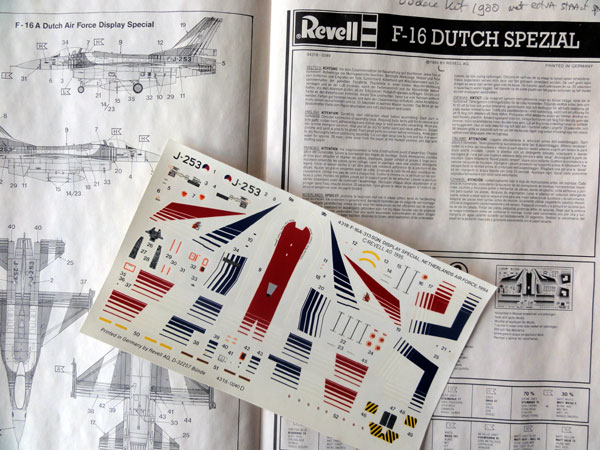
(the decals, of which I have 2 sets, will be used for another KLu F-16A demo aircraft model in the future).
In this release the sprues with old goodies such as engine, its transport dolly and pulling tractor are still included. But the old stores in the kit are almost unusable and better replaced, if you have several kits this is no problem.
The kit has a good looking small standard intake and the option to set the rear air brakes open. But these look a bit crude and better set closed.
Panel lines are engraved though a
bit thick and do not look bad.
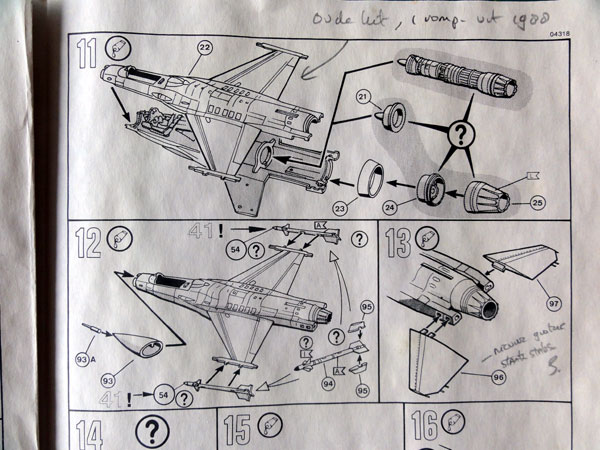
The Dutch aircraft had the long parachute fairing at the tail base.
So Revell included a new sprue in
this release with also this long tail parachute fairing as seen here...
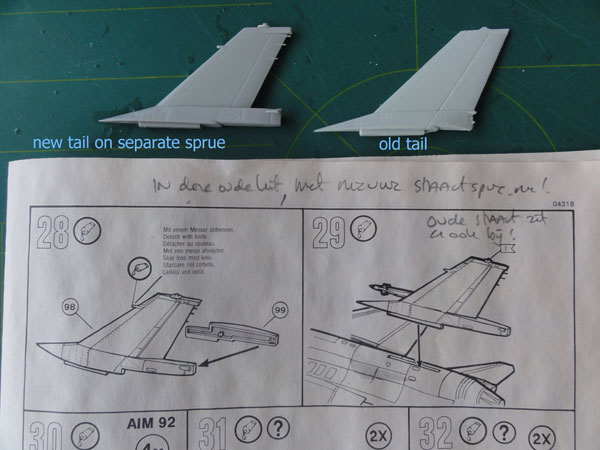
The sprues also had the new
enlarged
horizontal stabilizers that became standard on all
later/following F-16 Blocks. The wing tip missile launch rails
look to be the correct early style LAU-114.
It was decided to make the old model but with a few refinements:
- the kit vertical tail was still replaced by a spare one from the Revell F-16 MLU kit #04612 with long parachute fairing. It looked slightly better;
- the new horizontal stabilizer in the kit looks to be undersize and a bit thick; they were replaced with spare ones from a Hasegawa F-16 kit;
- the ventral fins (parts #49,50) were replaced by spares from a Hasegawa kit that look finer and better;
- the wheels of the kit are very basic with multiple parts enabling these to "rotate". They were replaced by much better spare wheels such as wheels #46 from a MLU F-16 kit;
- wing pylons came from spares from a Hasegawa kit; the kit parts are very basic and the kit fuel tank is a very different shape, so better discarded.
- a new spare ejection seat was to be set in place;
- the inside Pratt and Whitney F100 engine was not installed, only the exhaust.
The model was for the rest assembled. Filler was needed in many places but it can all be sanded smooth. I use often white Alabastine car filler/ putty for this.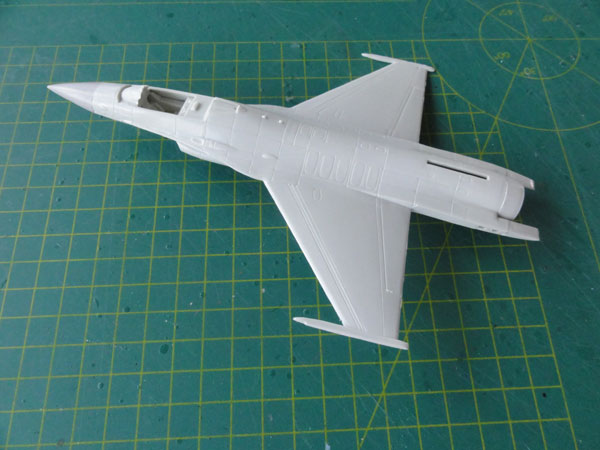

The main gear bay is undeep and just like the nose bay has no detail; it was decided not to refine this as not a lot is seen when the model sits.

![]() [16]
[16]

This kit scheme picked was a F-16A
Block 15 OCU aircraft as delivered to the Indonesian
Air Force TNI-AU (Tentara Nasional Indonesia - Angkatan Udara)
with first delivery of 12 aircraft being probably in 1990 under the program "Peace Bima Sena".
Decals would come from AZTEC
set 72-028 which is an excellent sheet with also plenty of detail
stenciling. (This set has also Italian F-16 ADF markings).
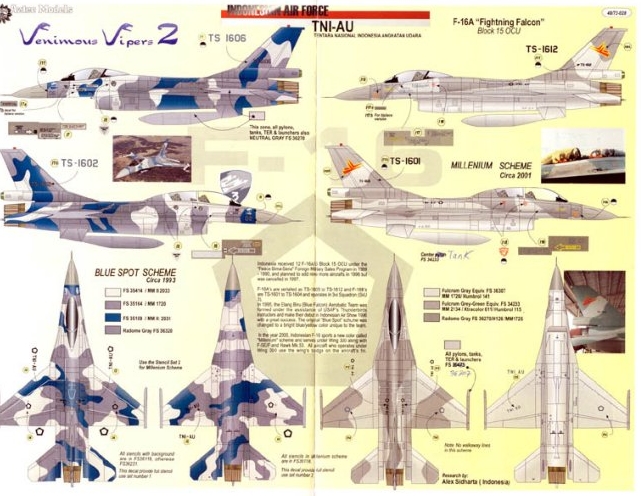
After assembly as described above a base grey coat was applied with the airbrush, any surface errors and gaps were corrected.
The Indonesian F-16 colours for the
desired "Millennium" scheme were a bit a guess.
AZTEC suggests:
(1) - grey "Fulcrum" like FS36307
(Humbrol 141 enamel) ;
(2) - pattern with medium grey-green
"Fulcrum" about FS34223 (Humbrol 115);
I used these acrylic paints to be
airbrushed:
(1) overall first a base Gunze
Sangyo H324 light grey coat applied;
(2) a mix of 50% Gunze Sangyo H321 light brown
+ 50% Gunze Sangyo H324 + drop of dark blue; this second colour was determined
looking at various photos.
Before applying the second colour, masking was done for which I used Revell Masking Film and low tack tape.
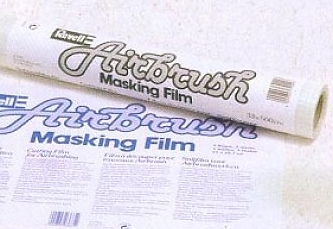

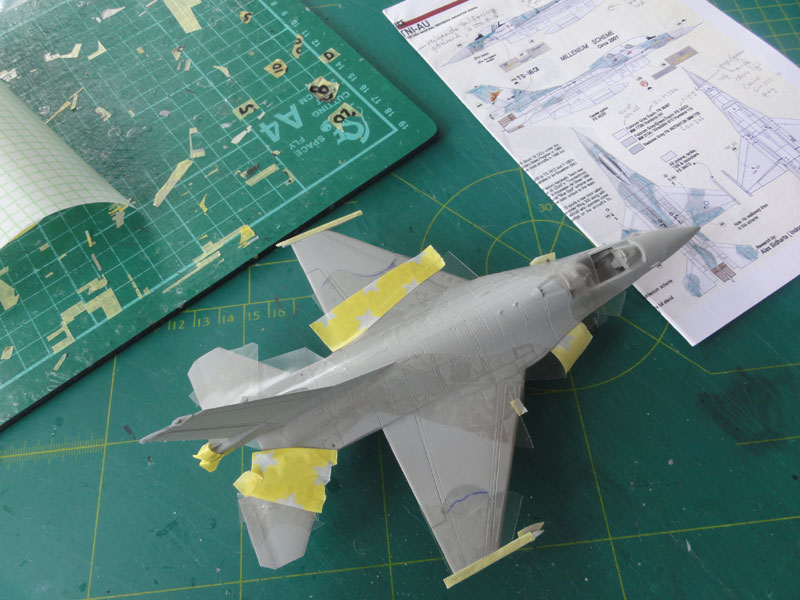
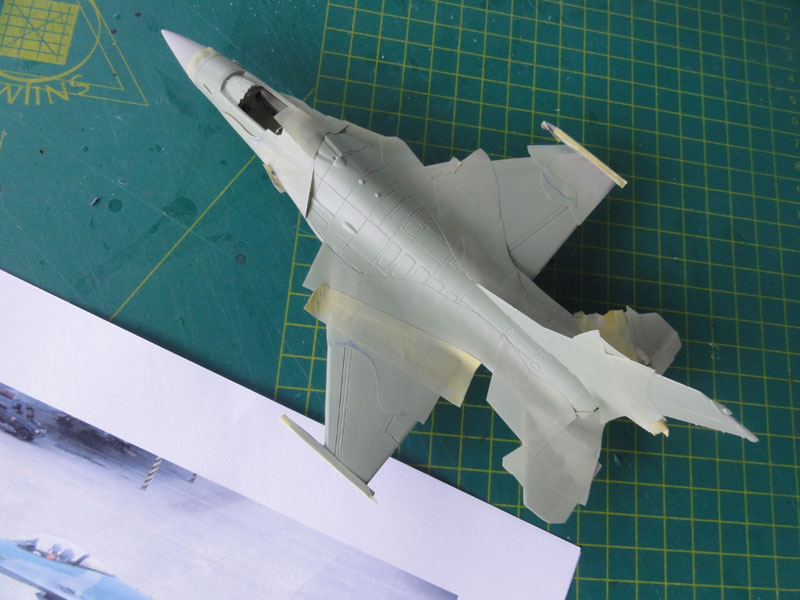
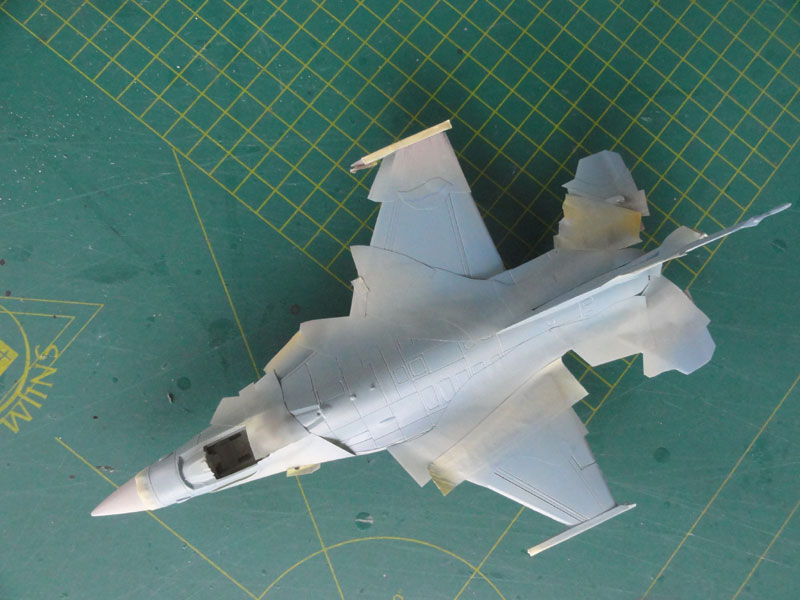
The other colours were also applied
such as white inside gear bays, doors and so on. Some with the airbrush,
some by brush painting
The landing gears were installed but with much better spare wheels from other F-16 kits. (Search for the thin wheels, so not the thicker ones of later Block F-16's).
The single piece kit canopy has a slight smoke sheen and looks good. Part of the inside frame was painted black. It was to be set closed and the tiny surrounding gaps were filled with white glue and painted when dried.
The model now got prior to decalling a gloss coat to avoid "silvering". I airbrushed a thinned Johnson Future/ Pledge varnish applied in a few coats. Mask off the canopy when airbrushing the varnish.
The AZTEC decals 72-028 were set onto
the model. There appears not to be a lot of stenciling but there are a
few very dark walkways. These decals are excellent.
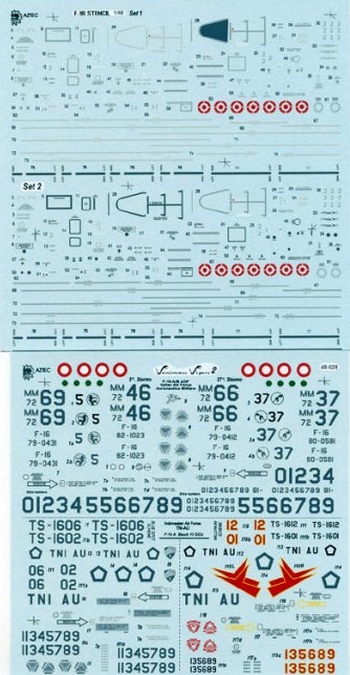
When done, a bit wash was added with a brush at the center fuselage maintenance panels and inside the gear bays and gear legs; a mix of acrylic varnish and black paint will do. Swipe off when applied, the corners and panels will retain the wash.
At all trailing edges fine static dischargers were added made from fishing wire (that were painted black).
The pitot tube was replaced and made of a metal needle; a second right side pitot was added as fitted aft of the radar nose.
The model got a semi-gloss varnish end coat with the airbrush with my usual technique... The canopy was masked off and set closed in place.
A nice F-16A model of TNI-AU was completed. (Another one will be made from an ESCI F-16B sporting the "Blue Spot" colour scheme, see below).
page 2
page 3
page 4
page 5
page 6
page 7
page 8
page 9
page 10
page 11
page 12
page ...
page ......
INDONESIA
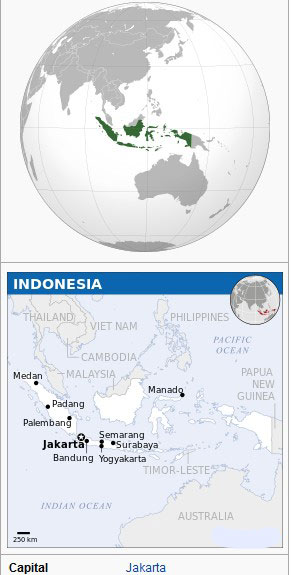
 ..
..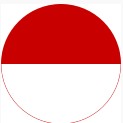 ..
..
[ 1,900,000 sq.km on thousands of island | Population > 270 million with some 700 languages | Capital: Jakarta | GDP US 4,000 per capita ]
After the end of the Second World War Indonesia fought a war to gain independence being a former Dutch colony. Nationalists under leadership of Sukarno declared independency on August 17,1945. Militia used a few Japanese abandoned aircraft during the first stages of the fights against the Dutch colonial armed forces and set up their own air force: ANGKATAN UDARA REPUBLIK INDONESIA, or AURI. The war in the region was known by the Dutch as "politionele acties" with thousands of victims and killed soldiers. Under United Nations and American pressure Indonesia gained independence in December 27, 1949 (except West Papua New Guinea). It was agreed that many Dutch air force aircraft were transferred to the new Indonesia Air Force like P-51's, C-47's, B-25 and others.
The first jet aircraft was purchased being the British De Havilland DH-115 Vampire arriving February 1956. Relations with the Soviet Union were tightened and MiG aircraft were received like a few MiG-15 UTI (Cs-102) trainers, 30 MiG-17 and later from Poland from 1958 MiG-17PF (Lim-5P) and some 32 Il-28 bombers. Also some 20 Avia Type 14 and 33 trainers were received. (It seems that also China delivered aircraft but not confirmed). Beginning 1960s, also large Tupolev Tu-16 "Badger" bombers and some 10 MiG-19 and 20 supersonic MiG-21 F13 fighters were delivered.
In August 1962 the Dutch transferred their still controled region Papua Nieuw Guinea to Indonesia under United Nations and US pressure. It was now called Irian Jaya.
In 1965 Suharto did a putch and came into power with his generals, ending the tight Soviet relations. From the USA, B-25 and C-47 and additional F-51 aircraft were obtained. Meanwhile, many former Russian aircraft were no longer operational. Some 18 F-86 / CAC-27 Sabre from Australia and 16 ex-USAF T-33 trainers came. In 1970s, Hawker Siddeley Hawks were purchased and OV-10 Bronco. In 1975, Timor a former Portuguese colony was occupied after it seeked its own independence. In the 1980s other types were some 16 second hand ex-IAF A-4 Skyhawks and some 16 F-5E/F Tigers. Various transport aircraft and helicopters were also used including Fokker F-27's and later C-130 Hercules.
Beginning 1990s followed 12 second hand F-16A/B aircraft and even half a dozen Russian Sukhoi Flankers despite a arms boycot in 2003. Bad economic conditions grounded many aircraft in the air force fleet. In 2010 the USA agreed to deliver another 24 ex-USAF F-16 Block 32 aircraft. Other newer aircraft were also ordered and delivered such as Korean T-50 jet trainers with Korea becoming a large arms supplier. Februari 2022 it was announced that Dassault Rafales had been ordered for the TNI-AU with 6 signed for + 36 options to be delivered in 2027. The Hawks will be phased out. It also appears that the F-15ID, an Indonesian F-15EX is considered. July 2023 it was announced that ex-Quatar Mirage 2000 will be bought as stop gap before the Rafales arrive.
The airforce has a large variety of aircraft with over 37,000 personnel and a dozen air bases spread over the large archipel.
------
The Indonesian Army TNI-AD obtained after independence several transports like DC-3/ C-47, DHC-2 and various Aero Commanders. Some Mil helicopters came in 1965 and Alouette III and many years later Bell and Bolkow Bo-105 helicopters. IPTN C-212 transports came in the 1990s. Latest types are Mil Mi-35 and Mi-17.
------
Also a naval aviation was set up after gaining independence. The ALRI (later TNI-AL) obtained from 1957 some 18 Fairey Gannets from the UK. In the 1960s, Mil helicopters arrived as well as Il-28 "torpedo bombers". After the 1965 coup, Western types were introduced including S-2 Tracker and GAF N-22 Nomad. From 1981 ex-Dutch Wasp helicopters came and modern GAF N-22Sl from 1981. Super Puma Exocet equiped helicopters were delivered and local manufactured IPTN CN-235 aircraft and additional GAF N-22's and few Buffalo transports. Most recent types are SOCATA trainers and PZL M28 aircraft.

F-16A Block 15 OCU of TNI-AU
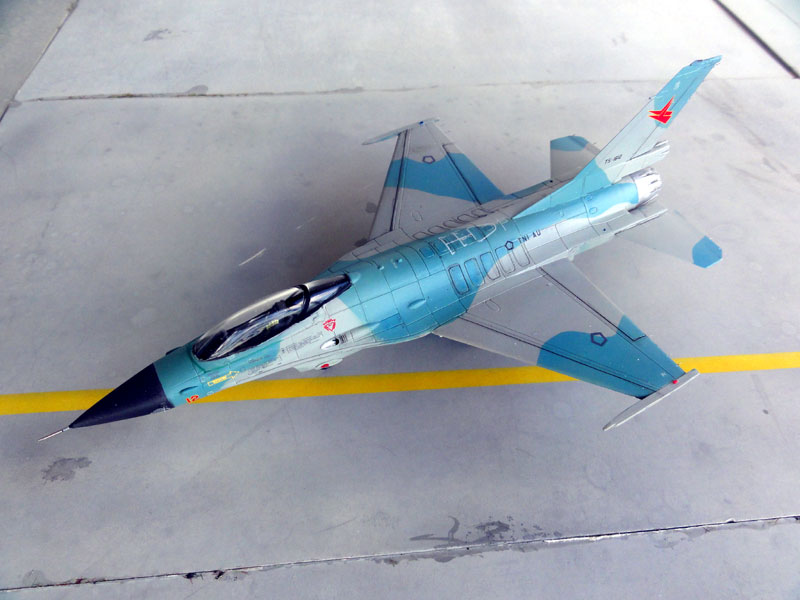
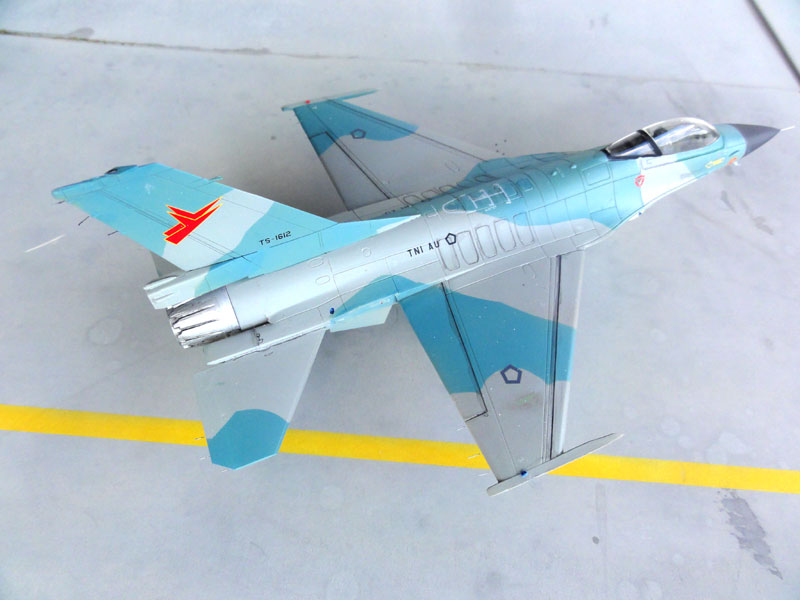
A very nice scene on an Indonesian
Air Base...
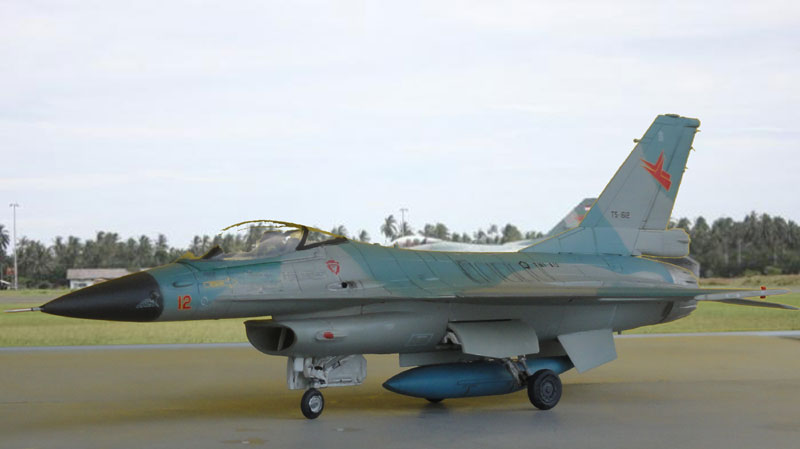
F-16A Block 15 OCU of TNI-AU. Probably of Skadron Udara 3,
Iswahyudi air base near Madiun, Indonesia, 1990s.
 [ 22]
[ 22] Another model of the Indonesian F-16 fleet was made, now using the old ESCI F-16B kit #9028 also briefly described on the very first page 1...
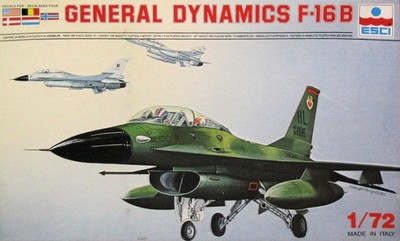
The ESCI F-16B will be made in another sort of "Blue Spot" Indonesian AF scheme of a F-16B Block 15 with Pratt and Whitney F100 engine and initial (small) main intake. Decals came from AZTEC set 72-208.
The assembly started and the rear of the intake tunnel was cut open to deepen a bit the intake. (though later on I decided to simply add an intake cover).
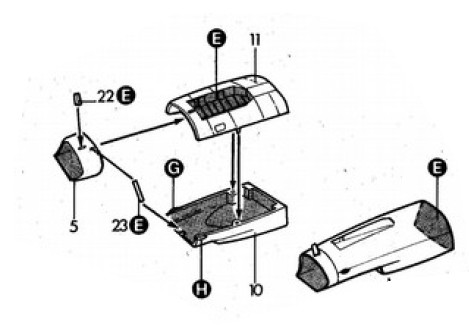
The kit has the small early F-16 Block stabilizers so this needs replacement; fortunately I had a pair of spares from a Hasegawa kit that were used.
In the central beam of the main gear bays a hole was made as seen in all F-16's.
The ESCI vertical kit has a choice for the USAF style or for longer parachute fairing with part #35. For this model the applicable long fairing was used.
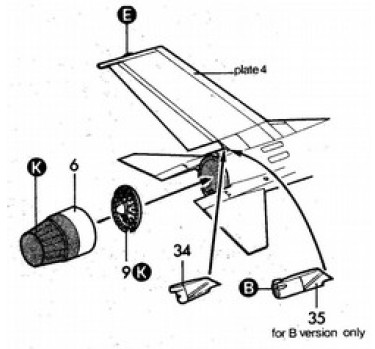
The canopy of this kit has no "loose frame", so the only option is to set it closed. Note that the canopy part to be integrated with the upper fuselage is separate in a sprue and now for a two seater dual. (in the ESCI F-16A single seater this part is different).

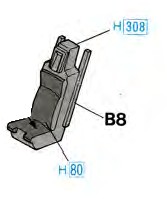
The kit cockpit interior was detailed at this stage with smaller bits. Spare ACES seats #B8 were used from Hasegawa kits and straps and harnesses added. The main cockpit interior was painted medium grey and darker grey details on the instrument consoles. The canopy was set, small gaps closed with white glue. Some details can be clearly seen inside the cockpit.
After all was dry, the big canopy was masked and the model got a light grey base coat (often I airbrush Revell aqua 75 "steingrau" for this). Any small surface errors and gaps were repaired with putty as needed.
The model was to be kept clean without any pylons or stores. ( If you want stores it is better to seek better parts from other F-16 kits such as the Hasegawa or later Revell F-16 kits).
Time for the paint scheme. This particular Indonesian F-16B has a wrap-around camouflage pattern. The colours were used that were a bit brighter, possibly because the photos seen on the internet showed relatively fresh painted aircraft.
The airbrushed acrylics were:
(1) first overall Gunze Sangyo 338 light blue/grey (suggesting FS354140), alternatively use H324 light grey;
Masking done and....
(2) medium blue suggesting FS35019 by airbrushing a mix of 70% Gunze Sangyo 338 + 30% Gunze Sangyo H25 ;
(3) darker blue FS35164 airbrushing Gunze Sangyo H25.
The radar nose radome was airbrushed FS36320 grey.

Also a spare white decal was airbrushed, just in case any paint repairs are needed later on. The result....

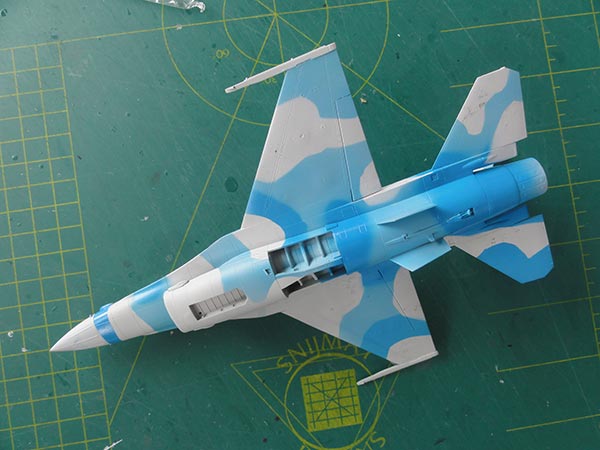
The exhaust pipe was painted and before decalling a few gloss varnish coats were airbrushed to avoid "silvering". The AZTEC 72-028 decals are fine and thin. The walkways lines are the light grey variant.
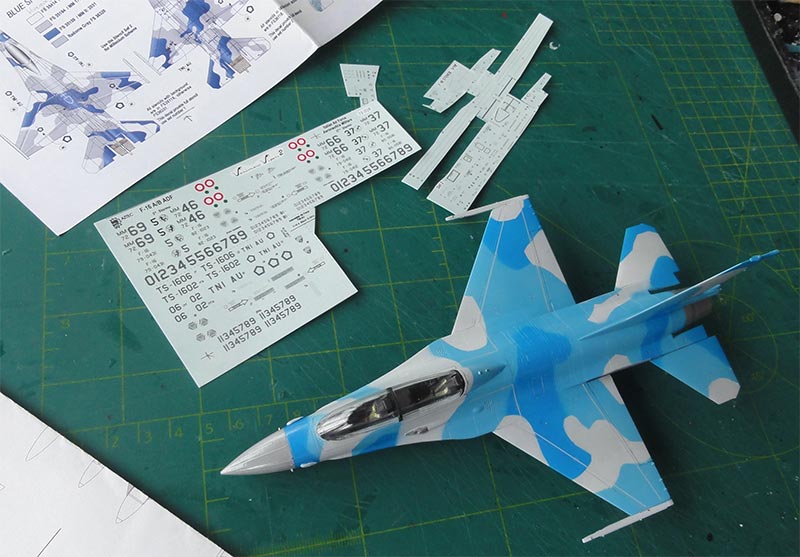
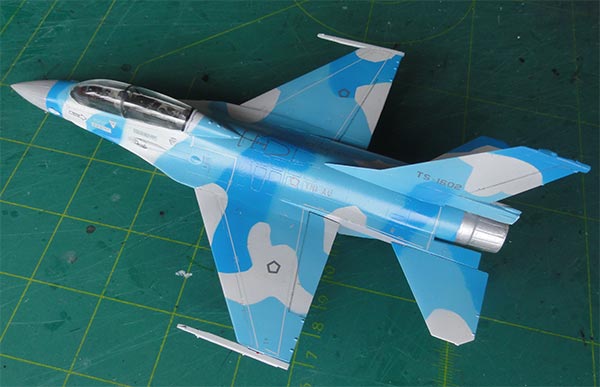
After decalling, the gear bays, undercarriages were added. All was painted white. A bit of plastic to suggest the battery was also added in the main gear bay. The undercarriage legs got some thin scrap metal wires to suggest hydraulics.
A little bit of weathering was done at the gear bays and at the upper fuselage access panels with a soft pencil and at the inboard flaps.
The smaller bits were added like the nose pitot, the pitot on the right side aft of the radome and the anti-collision lights painted red and dark blue. Also the many static dischargers made from fishing wire.
I also installed a red intake cover for a parked aircraft as I did not like how the intake tunnel looked in the kit. The cover was made of thin card painted red.
A semi-matt varnish coat was finally airbrushed using a mix of Johnson Future/Pledge gloss varnish mixed with say 10% Tamiya Flat Base X-21 and a drop of glycerine to improve flowing.
That completed this Indonesian F-16B in a special scheme.





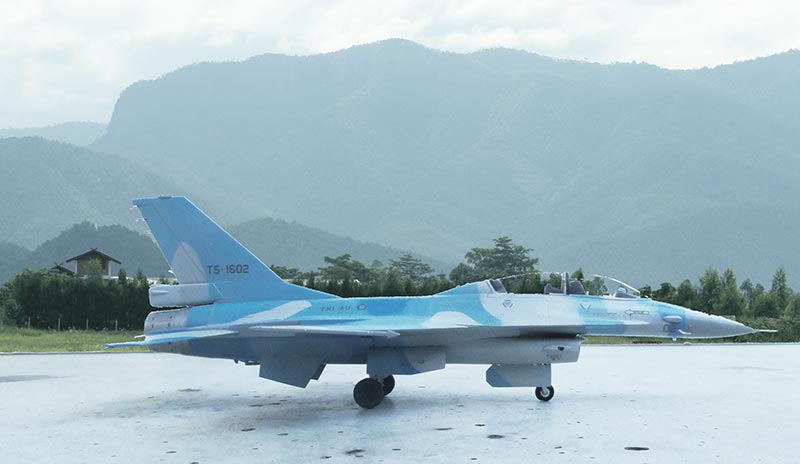
..

(c) Copyright "designer"/ All rights reserved. Your comments are welcomed by webmaster
Created this page
April 16, 2017

